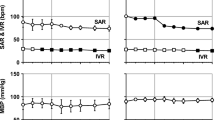Abstract
We investigated effects of a new Na+ channel blocking antiarrhythmic drug, A-2545, N-3 (2,2,5,5-tetramethyl-3-pyrroline-3-carboxamido)-propyl-phthalimide-hydrochloride, on various canine ventricular automaticity arrhythmias induced by two-stage coronary ligation, digitalis and adrenaline, and compared them with those of mexiletine. A-2545 showed antiarrhythmic effects, significantly decreasing the arrhythmic ratio of 24-h and 48-h coronary ligation-, digitalis- and adrenaline-induced automaticity arrhythmias. The antiarrhythmic plasma concentrations (IC50) of A-2545, 2 mg kg–1 10 min–1, i.v., for 24-h and 48-h coronary ligation-, digitalis- and adrenaline-induced arrhythmias were 1.8, 1.3, 5.8 and 3.7 µg ml–1, respectively, and that calculated for oral A-2545 (25 mg kg–1) in 24-h coronary ligation-induced arrhythmia was 1.8 µg ml–1. A-2545 is specifically potent in suppressing coronary ligation-induced arrhythmias, i.e., decreasing the arrhythmic ratio nearly to zero by oral administration, and among the intravenously given experiments A-2545 was effective at lower concentrations than other arrhythmia models; A-2545, 2 mg kg–1 10 min–1, was equipotent to 5 mg kg–1 10 min–1 mexiletine in suppressing 24-h coronary ligation-induced arrhythmia, indicating that A-2545 is more potent than mexiletine. In order to determine whether A-2545 has arrhythmogenic effects, we used programmed electrical stimulation (PES)-induced reentry arrhythmias in dogs with old myocardial infarction and compared effects of A-2545 and flecainide. A-2545, 2 and 5 mg kg–1 10 min–1, significantly suppressed the PES-induced arrhythmias in all six dogs without aggravating them. These arrhythmias were not markedly suppressed by flecainide either with 1 or 3 mg kg–1 10 min–1; moreover even in one out of six dogs aggravation of arrhythmia was noted after 1 mg kg–1 10 min–1. In conclusion, A-2545 suppressed various canine ventricular arrhythmias, and the antiarrhythmic effect of A-2545 was more potent than that of mexiletine, and A-2545 did not show arrhythmogenic effects compared to flecainide.
Similar content being viewed by others
Author information
Authors and Affiliations
Additional information
Received: 16 February 1998 / Accepted: 7 October 1998
Rights and permissions
About this article
Cite this article
Xue, Y., Arita, J., Aye, N. et al. Effects of an antiarrhythmic drug A-2545 on canine ventricular arrhythmia models; comparison with mexiletine and flecainide. Naunyn-Schmiedeberg's Arch Pharmacol 358, 649–656 (1998). https://doi.org/10.1007/PL00005307
Issue Date:
DOI: https://doi.org/10.1007/PL00005307




